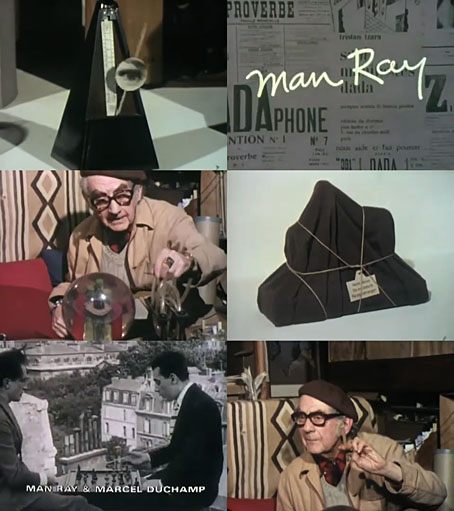Documentaries about art in the 20th century are often compromised by a lack of interview material, as a consequence of which you tend to see the same few clips used again and again. What you don’t see so often are the original interview films which provided the source of those extracts. I turned up one of these a couple of years ago, Rebel Ready-Made, a film about Marcel Duchamp from 1966. Another popular source of sound-bites is the Monitor episode with Roland Penrose interviewing Max Ernst, something I still haven’t seen in full, and this short film about Man Ray from 1972. All three interviews were BBC productions, the Man Ray film having been made for the Review strand as a result of a recent exhibition of Man Ray’s work in Paris. The version linked to here was a repeat screening whose introduction suggests there might have been more footage in the original broadcast. If so, this is still more of this particular interview than I’ve seen before, with Man Ray discussing the creation of some of his Dadaist objects—The Gift is referred to—as well as the photo portraits he made of the many artists, writers and composers passing through Paris in the 1920s. At 15 minutes the film is far too short, Man Ray’s wide-ranging career—painter, object-maker, photographer, film-maker—deserves a more substantial appraisal, but it’s good to see him talking all the same.
Previously on { feuilleton }
• Man Ray and the Marquis
• Emak-Bakia
• Dreams That Money Can Buy
• Entr’acte by René Clair


One of the first ornamental objects that I bought when I got my first job was a metronome onto which I duly blu-tacked a photocopy of Man Ray’s own eye from his self-portrait with half a beard. I had it for many years but eventually it sadly succumbed to gravity which resulted in a bent pendulum.
We visited the Penrose’s home at Farley Farm in Sussex where they give small-group guided tours (topped off by tea and cake) and were lucky enough to have it conducted by Roland and Lee Millar’s son, Antony, who had many interesting tales about the Art along with anecdotes about the Artists who frequented their home and his family life in such an atmosphere. It house was a box of wonders, choc-full of things to gawp at and well worth a visit if you’re ever down this way, although I would add that it isn’t open all the time so you have to check first and book a place.
*The house
Ha, now I’m tempted to get a metronome myself so I can make my own Object to Be Destroyed! Ideally with the lenticular opening/closing eye he used for the later versions…
I wouldn’t mind seeing the Penrose house either. I’ve a lot of time for Roland, always recommend his book on Picasso if people want a single volume about the man’s life and work.
Bearing in mind that in the Sixties, as was noted, The Stones seemed to follow The Beatles’ lead so to speak, only three months afterwards, I was amused when I received my Sgt. Pepper 50th anniversary box set, to find that the box had a 3D lenticular version of the cover on which their heads moved to follow you around the room, in a similar vein to the one on the original “Satanic Majesties”…
Off topic but I thought of another Neo-Psych band that might amuse you; Brighton band Vibrasonic, whose eponymous album from 1994 is an absolute hoot:
https://youtu.be/C8j6wqyugZs?feature=shared
Yes, that’s the real deal! And I see I have it on Children Of Nuggets although it didn’t ring a bell since I’ve never played that collection very much. I ought to go looking for their album.
I enjoyed the fad in the 1970s for lenticular gimmicks, even those tacky religious postcards. The only thing I have now is one of the more pointless additions to the Blade Runner Voight-Kampf DVD box, a perspex block with Deckard in lenticular profile waving his gun around.